Vickers-Armstrongs Viscount 745
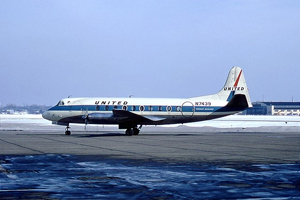
United Airlines Flight 297, N7430
Ellicott City, Maryland
November 23, 1962
United Airlines Flight 297, a Vickers-Armstrongs Model Viscount 745D airplane, was en route between Newark, NJ and Washington, D.C., at an assigned altitude of 6,000 feet when it struck at least two whistling swans, one on the left horizontal stabilizer and one on the right. The bird impacting the right horizontal stabilizer caused superficial damage whereas the bird strike on the left horizontal stabilizer penetrated into the most forward point of the leading edge. This caused the left horizontal stabilizer to fail and rendered the airplane uncontrollable. All thirteen passengers and all four crewmembers were fatally injured.
The Civil Aeronautics Board determined that the probable cause of this accident was a loss of control following separation of the left horizontal stabilizer which had been weakened by a collision with a whistling swan.
United Airlines Flight 297 was a scheduled flight from Newark, New Jersey, to Atlanta, Georgia, with planned en route stops at Washington, D.C., Raleigh-Durham and Charlotte, North Carolina. There were thirteen passengers and four crewmembers on board.
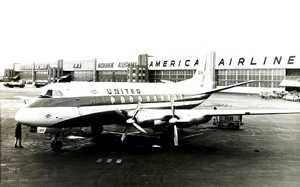
Flight 297 departed Newark at 1139 EST. Following a position report at West Chester very high frequency (VHF) omni-directional radio range/tactical air navigation VORTAC at 1203, control of the flight was transferred from the New York Air Route Traffic Control Center (ARTCC) to the Washington Air Traffic Control Center. The flight progressed normally and at 1214 was cleared to descend from 10,000 to 6,000 feet. The following advisory was issued to Flight 297 at 1219: "Be advised there have been numerous reports of a considerable amount of ducks and geese around this area." This report was acknowledged and a radar handoff to Washington Approach Control occurred at 1220.
At 1222 Flight 297 received a vector and additional information that was acknowledged. An additional vector was transmitted at 1223; however, there was no reply from Flight 297. At 1224 it was determined that radar contact had been lost.

The nearest official weather observing station to the scene of the crash was at Friendship International Airport, Baltimore, Maryland. The 1200 report indicated scattered clouds at 5,000 feet and 20 miles visibility. This was followed at 1300 by a report of clear and 20 miles visibility.
Statements were obtained from several eyewitnesses to the accident. A consensus of their observations is that Flight 297, when first sighted, was at a very low altitude turning to the left on an east or southeast heading. The airplane abruptly rolled inverted and disappeared through the trees in a vertical attitude. Some shiny objects, later identified as parts of the airplane, were observed falling in the immediate area of the crash.
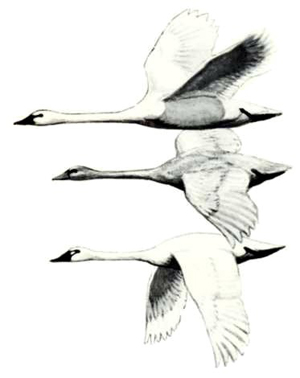
A statement was also obtained from a pilot who was flying in the vicinity of Beltsville, Maryland at approximately 1230 on the date of the accident. He reported sighting a flock of approximately 50 very large white birds flying in trail and estimated their altitude to be 5,500 feet, level with him in an area bounded by Ellicott City, Savage, and Clarksville, Maryland. This position would place the birds within a maximum distance of eight miles from the crash site. He was uncertain of their flightpath because of insufficient relative motion. (Map plotting the location from eyewitnesses)
There were also reports from airline pilots flying in the area that radar contacts reported to them by Washington Center were in fact large flocks of birds. In addition to these reports, the Weather Bureau radar log at Washington National Airport indicated echoes described as "birds" or "angels" (contacts of unknown origin, not associated with precipitation, thought to be birds or insects) which were sighted throughout a period from 0815 until 1705. At 1245 these echoes were described as scattered over a 30-mile radius from the station moving from the north-northeast at 30-40 knots. The crash site is approximately 23 miles from the radar site.
Bird remains were found on both horizontal stabilizers, indicating two distinct bird strikes on these surfaces. Superficial damage occurred on the right horizontal stabilizer, 22 inches outboard of the fuselage. This strike was a glancing blow and did not result in penetration. The other strike was on the left horizontal stabilizer, approximately 49 inches outboard of the fuselage. (Drawing of the left horizontal stabilizer) In this instance the bird penetrated the leading edge and passed through the leading-edge member. Continuing aft, the bird fractured the spar web, partially separating it from the top and bottom caps, and then made final contact with the lower leading edge of the elevator, which resulted in denting but no penetration.
The left horizontal stabilizer and elevator failed along a chord plane generally following the travel of the bird through the structure. The direction of failure was downward and slightly aft. In addition to this failure, the right horizontal stabilizer and elevator separated downward and aft approximately 57 inches from the fuselage. Subsequently, the weakened inboard portion of this horizontal stabilizer also failed.
Information obtained from the flight data recorder (FDR) (a Lockheed Model 109C) indicated that heading, airspeed, vertical acceleration, and altitude traces became suddenly excursive at approximately the same time. In less than one minute from this point, the altitude went from approximately 6,000 feet to ground level and the airspeed increased from 240 to 365 knots indicated air speed and then dropped sharply into an unreliable range. During this same interval, the heading varied erratically, generally in an area of 210 degrees to 180 degrees, and the vertical acceleration changed from a reading of 1.7 positive to a variable 3.0 negative G's.
Examination of all four engines indicated power at impact. There was no evidence of bird ingestion or any abnormal conditions in the operation of any of the engines prior to impact. The severe ground fire damage following impact eliminated any possibility of discovering evidence of additional bird strikes which might have occurred on other portions of the airplane.
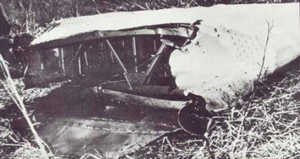
Subsequent to the accident, a partial bird carcass consisting of a large piece of skin covered with white feathers was found ten feet from the separated section of the left horizontal stabilizer. The skin measured nineteen inches in length and nine inches in width. Specimens of feathers, tissue, and blood were obtained from the separated parts of the airplane and that portion of the horizontal stabilizer still attached to the fuselage. The Chief Medical Examiner for the State of Maryland determined these tissue and blood specimens to be of bird origin. The specimens and carcass were later identified to be an Olor Columbianus (whistling swan). The largest concentration of these birds on the North American continent at this time of the year is in the Chesapeake Bay area. The average weight of the birds established by the Fish and Wildlife Service of the U.S. Department of Interior was 14 pounds for the male and 11.5 pounds for the female; however, they are known to attain weights in excess of 18 pounds.
Flight 297 progressed according to flight plan, with no indication of any mechanical difficulty being disclosed by the flight crew in their many communications with ground stations en route. The weather along the route of flight is not considered a contributing factor to the accident.
As a result of the numerous radar contacts by Washington Center, which were identified as bird flocks, other pilot reports and ground-observer sightings of flocks in the entire general area of the accident, there is no doubt that a definite hazard of in-flight collision with birds existed at the time of the accident.
Flight 297 struck two birds (identified as whistling swans), one on the left horizontal stabilizer and one on the right. The damage inflicted by each of these birds is of great variance, and therefore was the subject of close examination. The determining factor in the degree of damage was the angle of impact in relation to the surface of the airfoil at the point of impact. If the bird's line of force was elevated above or below the most forward point of the leading edge of the horizontal stabilizer, the angle of contact would become more oblique, thereby diminishing the force imposed and, consequently, the likelihood of penetration.
The bird impacting the right horizontal stabilizer struck the leading-edge surface 2-3 inches above the most forward point of the leading edge. Curvature of the airfoil in this area resulted in impact on a surface sufficiently oblique to the line of force to produce bird deflection rather than bird penetration. The result was superficial damage only.
In contrast, the bird strike on the left horizontal stabilizer was concentrated nearly at the most forward point of the leading edge. At this point the angle between the line of force and the stabilizer skin resulted in penetration. The damage sustained in this instance weakened the structure so that the normal down load initiated immediate failure of the horizontal stabilizer and elevator along a chord directly aft of the initial impact point. As these parts failed downward and slightly aft, a violent instantaneous nose-down pitching moment was generated. During the left horizontal stabilizer failure sequence, the elevators were displaced beyond their limit, trailing edge upward, thus imposing a severe down load on the right horizontal stabilizer which also failed downward. As the outboard eleven feet of the right horizontal stabilizer and elevator were in the process of separation, they weakened the structure of the remaining inboard stabilizer section, which subsequently separated prior to impact. This breakup rendered the airplane incontrollable.
Probable Cause
The Civil Aeronautics Board (CAB) determined that the probable cause of this accident was a loss of control following separation of the left horizontal stabilizer which had been weakened by a collision with a whistling swan (CAB Report). (Probable Cause)
The CAB, in the analysis of this accident and its effect on the industry and the public, has made the following observations which it considers to be most appropriate to the bird strike problem:
1) The low incidence of tailstrikes noted in Civil Aeronautics Administration (CAA) Technical Development Report No. 62, dated January 1949 (CAA Technical Development Report No. 62) may no longer be true as a result of the changes in airplane design. The horizontal stabilizers of transport airplanes of that early era were shielded by propeller discs and wings and were relatively protected from strike damage. Many of the propeller-jet airplanes have the tailplanes mounted higher than the top of the propeller discs; the jet airplanes, of course, have no propeller discs and their high - mounted tails make them even more vulnerable. The trend toward T-tail and the canard supersonic designs is interesting in that the horizontal stabilizer has no protection afforded by the fuselage, wings, and power plants.
2) The considerably higher climb and descent speeds of current generation airplanes can result in a higher percentage of severe structural damage strikes than reported in the earlier survey.
3) Although the subject strike involved failure of a tail surface, conceivably tomorrow some other vital component, such as a spoiler, wing flap, control surface, or control tab could be involved. Impairment of a vital control function could have equally catastrophic consequences. Therefore, consideration should be given to broadening the present requirements to ensure overall protection against catastrophic damage from bird strikes.
4) CAA Technical Development Report No. 62 has been of considerable value in evaluating the importance of the bird strike problem. Unfortunately, it is outdated, and a new study, based on the currently operating airplanes and the greater traffic density, is indicated.
The CAB recognizes that any project established to evaluate and attempt solution of catastrophic bird strike damage will be a colossal undertaking, but the problem is no less colossal. Accordingly, the CAB recommended to the CAA Administrator that the program already underway in this regard be modified to include consideration of broadening the present bird strike requirements. It has been further recommended that physical testing be included to corroborate any analytical studies, and that a new survey of bird strikes be made similar to those reported in CAA Technical Development Report No. 62.
At that time, the only regulation relevant to bird strikes was section 4b.352 for "Windshield and windows," of the Civil Aviation Regulations (CARs) (CAR 4b.352), and section 4b.612 "Flight and navigational equipment," of the CARs (CAR 4b.612) (for pilot tubes segregation). (Summary of large bird strikes airworthiness standards)
CAR 4b.352 was amended in December 1953
- (a) All internal glass panes shall be of a nonsplintering safety type.
- (b) The windshield, its supporting structure, and other structure in front of the pilots shall have sufficient strength to withstand without penetration the impact of a four-pound bird when the velocity of the airplane relative to the bird along the airplane's night path is equal to the value of Vo at sea level selected in accordance with paragraph (b)(4) of section 4b.210, "Flight controls," of the CARs (CAR 4b.210 (b)(4)).
CAR 4b.612 (adopted in January 1952)
- (a)(6) Where duplicate air-speed indicators are required, their respective pitot tubes shall be spaced apart to avoid damage to both tubes in the event of a collision with a bird.
Note: there were no regulations for structure protection at the time of this accident.
In the early sixties, the situation was as follows: "Collision with birds has, of course, been a problem for many years, but during aviation's formative years it was predominantly one of nuisance. The speed of earlier airplane was such that damage was usually minor. This slow speed of earlier designs also resulted in slow rates of closure and short maneuver distance so that some degree of evasion was possible. Even then, however, it was recognized that airplanes had a prime point of vulnerability, the windshield, and following several years of study and testing, regulations (such as CAR 4b.352) were promulgated to require a measure of protection through the use of strengthened windshields." (Source: CAB accident report)

The bird strike certification standards were incomplete at time of certification and only focused on windshields.
A single point failure on the spar of the empennage was present. The geometry of the airplane (tail-planes mounted higher than the top of the propeller discs) and the higher speeds of this newer turboprop-type airplane design increased its vulnerability to bird damage.

The see-and-avoid rule for bird avoidance was assumed to be working for the majority of cases despite the technology improvements that led to higher speeds, and thus less time for detection and avoidance.
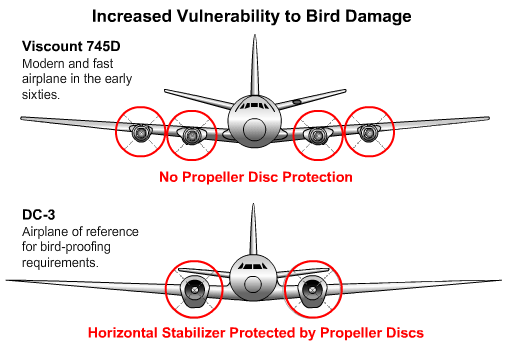 In the early sixties, the industry was satisfied that further "bird-proofing" requirements were unnecessary in the consideration of the fact that serious damage to such items as antennas, dents, and even holes in wings, cowlings, and fuselage do not in themselves render an airplane incapable of further flight. Following the windshield program, concluded in February 1950 by the CAA Technical Development Report No. 74 (CAA Technical Development Report No. 74), there was no industry-concerted effort toward further "bird-proofing," nor was there any indication of its necessity. One of the conclusions of the 1949 bird-strike report (CAA Technical Development Report No. 62), "No record exists of any fatality in air carrier operations in the United States caused by collision with bird" - remained valid for many years, until October 4, 1960. The CAB determined that the probable cause of the Boston Electra accident (discussed in the "Precursors" page for this accident) was the unique and critical sequence of the loss and recovery of engine power following bird ingestion, resulting in loss of airspeed and control during takeoff. One could reason that if the initiating conditions were to be repeated over and over, another accident probably would not result. This graphic compares the Viscount 745D to the DC-3 aircraft. The Viscount aircraft does not have propeller disc protection. In the case of the Viscount, however, one bird caused immediate separation of a horizontal tail surface, rendering the airplane permanently out of control.
In the early sixties, the industry was satisfied that further "bird-proofing" requirements were unnecessary in the consideration of the fact that serious damage to such items as antennas, dents, and even holes in wings, cowlings, and fuselage do not in themselves render an airplane incapable of further flight. Following the windshield program, concluded in February 1950 by the CAA Technical Development Report No. 74 (CAA Technical Development Report No. 74), there was no industry-concerted effort toward further "bird-proofing," nor was there any indication of its necessity. One of the conclusions of the 1949 bird-strike report (CAA Technical Development Report No. 62), "No record exists of any fatality in air carrier operations in the United States caused by collision with bird" - remained valid for many years, until October 4, 1960. The CAB determined that the probable cause of the Boston Electra accident (discussed in the "Precursors" page for this accident) was the unique and critical sequence of the loss and recovery of engine power following bird ingestion, resulting in loss of airspeed and control during takeoff. One could reason that if the initiating conditions were to be repeated over and over, another accident probably would not result. This graphic compares the Viscount 745D to the DC-3 aircraft. The Viscount aircraft does not have propeller disc protection. In the case of the Viscount, however, one bird caused immediate separation of a horizontal tail surface, rendering the airplane permanently out of control.
The low incidence of tail strikes noted in the 1949 report (Fact sheet on CAA TDC Report No. 62) was no longer true as result of the changes in airplane design. The Model Viscount 745D had a horizontal stabilizer mounted higher than the top of the propeller discs. This was not the case for the Douglas Model DC-3 (which represented the bulk of the airplane involved in the earlier studies) since its horizontal stabilizer was shielded from strike damage by its propeller discs and wings. In addition, climb and descent speeds of the next generation airplane became considerably higher that what had been reported in the earlier survey.
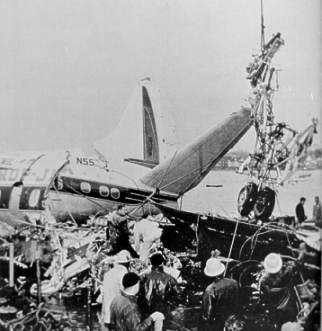
At the time of the Flight 297 accident, certification standards for bird ingestions were being discussed. This was initiated by the following accident:
On October 4, 1960, an Eastern Airlines Lockheed Model L-188A (Electra) turboprop ingested European starlings into all four engines during takeoff from Boston Logan Airport resulting in a multi-engine power loss. The airplane crashed into Boston Harbor, killing 62 people out of 72 on-board. It was determined that the probable cause of this accident was the unique and critical sequence of the loss and recovery of engine power following bird ingestion, resulting in loss of airspeed and control during takeoff. The accident prompted the FAA to initiate action to develop minimum bird ingestion standards for turbine powered engines.
See accident module
This accident led to the eight-pound requirement for empennage protection, which became the most constraining requirement for bird strikes. (Summary of bird strikes airworthiness standards)
As a result of the Flight 297 bird strike accident, section 25.631, "Bird strike damage," of the Code of Federal Regulations (14 CFR 25.631) was implemented through amendment 25-23, dated May 8, 1970 (35 FR 5665, April 8, 1970). NPRM for Section 25.631 - Bird Strike damage
14 CFR 25.631 States that the empennage structure must be designed to assure capability of continued safe flight and landing of the airplane after impact with an eight-pound bird when the velocity of the airplane (relative to the bird along the airplane's flightpath) is equal to cruising speed (Vc) at sea level, selected under paragraph (a) of section 25.335, "Design airspeeds," of the regulations (14 CFR 25.335(a)). Compliance with this section by provision of redundant structure and protected location of control system elements or protective devices such as splitter plates or energy absorbing material is acceptable. Where compliance is shown by analysis, tests, or both, use of data on airplanes having similar structural design is acceptable.
Airplane Life Cycle:
- Design / Manufacturing
Accident Threat Categories:
- Bird Hazards
- Structural Failure
Groupings:
- N/A
Accident Common Themes:
- Flawed Assumptions
- Unintended Effects
Flawed Assumptions
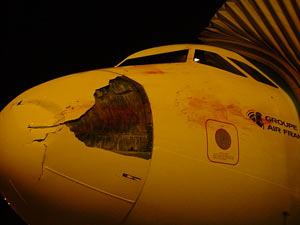
The absence of any fatal accident related to a bird strike meant that the bird-proofing requirements were deemed sufficient before the Viscount accident. The certification standards were actually incomplete and based on outdated data. The bulk of the fleet of reference used for the earlier bird-proofing studies was composed of Douglas Model DC-3 airplanes (designed in the thirties).
The scenario of a bird strike was not considered during the design and certification of the Vickers-Armstrongs Model Viscount 745D airplanes. The structure of the empennage was not resistant enough (nor fail-safe) to sustain a collision with a whistling swan. On the day of the accident, the bird penetrated the leading edge of Flight 297's left horizontal stabilizer and passed through the leading edge member. It continued aft and fractured the spar web, separating it from the top and bottom caps. The whole stabilizer subsequently failed.
Unintended Effects
The design of the Vickers-Armstrong Model Viscount 745D airplanes was such that the empennage was not shielded by the wing and was mounted higher than the top of the propeller discs, as well as higher airspeeds than were generally used by airplanes of the era. This resulted in a configuration which had a higher risk for bird strike, as well as the potential for greater damage when struck.
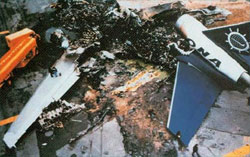
November 12, 1975: At 1309 EST, Overseas National Airways, Flight 032, a McDonnell Douglas Model DC-10-30 airplane began its takeoff roll on Runway 13R at JFK Airport, with 128 passengers, and 11 crewmembers. This was a non-revenue flight, as all the passengers were ONA employees. Shortly after accelerating through 100 knots, but before reaching the takeoff decision speed (V1), a flock of birds were seen to rise from the runway. The airplane struck many birds, and the takeoff was rejected. Bird strikes had damaged the No. 3 engine's fan blades, causing rotor imbalance. Fan-booster stage blades began rubbing on the epoxy micro balloon shroud material; pulverized material then entered into the engine's high-pressure compressor (HPC) area, ignited and caused the compressor case to separate. A fire erupted in the right wing and No. 3 engine pylon. The airplane couldn't be stopped on the runway. The pilot-in-command steered the airplane off the runway onto Taxiway Zulu at about 40 knots. The main undercarriage collapsed, and the airplane came to rest against the shoulder of the taxiway. The successful evacuation may be partially attributed to the fact that nearly all passengers were trained crew members.
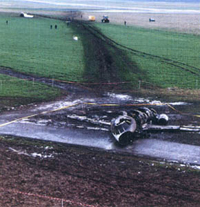
In this case, the NTSB determined that the most probable cause was related to the engines having ingested multiple large birds during the takeoff roll, culminating in a catastrophic engine failure. General Electric Aircraft Engines (GEAE), the engine manufacturer, based on the company's own determinations, arrived at a different conclusion as to the probable cause, primarily that the catastrophic engine failure had been the result of ingestion of wheel debris in combination with tire debris penetrating the engine core cowl and severing the engine fuel manifold line following the failure of one or more main landing gear wheels and tires during the ground roll.
The most recent accidents with multiple fatalities related to bird strikes are:
January 20, 1995: The Dassault Model Mystere-Falcon 20-E5 F-GHLN operated by Leadair Unijet encountered massive ingestion of birds on takeoff from Runway 25 at Paris-Le Bourget. The ingestion caused the uncontained failure of the No. 1 engine. Fuel lines were severed, and a fire erupted in the rear of the cabin, and control was lost while trying to carry out an emergency landing. The seven passengers and all three crewmembers were fatally injured.
September 22, 1995: As the U.S. Air Force Boeing Model E-3B Sentry, 77-0354 (a military Boeing Model 707-300 equipped with airborne warning and control systems (AWACS) rotated for liftoff at Elmendorf AFB, in Anchorage, Alaska. Numerous Canadian geese were ingested in the No. 1 and No. 2 engines, resulting in a catastrophic No. 2 engine failure and a stalling of the No. 1 engine. The flight crew initiated a slow-climbing turn to the left and began to dump fuel. The airplane attained a maximum altitude of 250 feet before it started to descend. The plane impacted a hilly, wooded area less than a mile from the runway, broke up, exploded, and burned. The 24 persons on board were fatally injured.
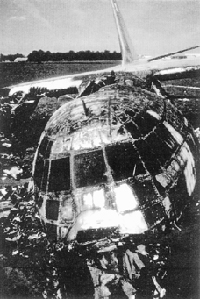
July 15, 1996: During a go-around at Eindhoven, the Netherlands, a Belgian Air Force Lockheed Model C-130H Hercules CH-06, chartered by the Dutch Air Force (Koninklijke Luchtmacht), ingested birds in both left-hand side engines (No.1 and No. 2), causing both engines to lose power. For undetermined reasons, the flight crew shut down engine No. 3 and feathered the propeller. The airplane then turned left and crashed on the left side of the runway. Within seconds a fire erupted, which was fed by the oxygen from the airplane's oxygen system. Some emergency exits in the main cabin were unreachable because of the fire while other exits could not be opened because of twisting of the fuselage. Of the 37 passengers on board, 34 were fatally injured.
Technical Related Lessons:
Impact with large birds can cause substantial, and in some cases catastrophic, damage to aircraft structure and systems. (Threat Category: Bird Hazards)
- At the time this airplane was certified, the only bird threat that was addressed by the regulations was penetration of the windshield. Although there had been numerous bird strikes to other areas of aircraft without catastrophic consequences, this accident exposed the vulnerability of the empennage structure.
Structural capability of new designs/configurations should be consistent with threats and loading spectra identified by applicable requirements. (Threat Category: Structural Failure)
- Designs of the Viscount era largely involved empennage structure being shielded by wings and propellers from inflight impact with large birds. The Viscount was the first widely used configuration which did not involve the same inherent protection. This vulnerability was exposed through analysis of this accident, and subsequently led to the eight-pound bird strike requirement for empennage structure. It also illustrates that, while airplane designs are evolving, standards previously assumed to be adequate, may later be found to be deficient. As improved understanding of the threats is gained, requirements may need to evolve as well.
Common Theme Related Lessons:
Introduction of new configurations, technologies, or operations has the potential of exposing new vulnerabilities. Conversely, existing configurations may be operating safely only because these threats are being inherently protected from exposure without deliberate design intent. (Common Theme: Unintended Effects)
- The design of the Vickers-Armstrong Model Viscount 745D airplanes (tail-planes not shielded by the wing and mounted higher than the top of the propeller discs) allowed the presence of a non-shielded single point failure on the spar of the empennage. Additionally, the higher speeds of this newer turboprop (in the early sixties) increased the amount of damage that could result from a bird.
Safety standards must be found to be consistent with the actual threat environment that will be experienced, including accounting for the actual conditions prevalent during the threat encounter. Assumptions are only valid if the related threat environment is properly defined. (Common Theme: Flawed Assumption)
- The standards applied to the Viscount were those that had been historically applied to the designs of that era and had operated successfully in the same environment to which the Viscount was being exposed. Since these standards did not address bird strike hazards to structure, it was assumed that the application of bird strike standards was not necessary. The assumption at the time was that the windshield was the only vulnerable area of the airplane, or was at least, the critically important aspect of the airplane structure. This accident exposed the vulnerability of the empennage structure, and the flaw in the assumption that airplane structure, other than the windshield could be catastrophically damaged by a bird strike.

